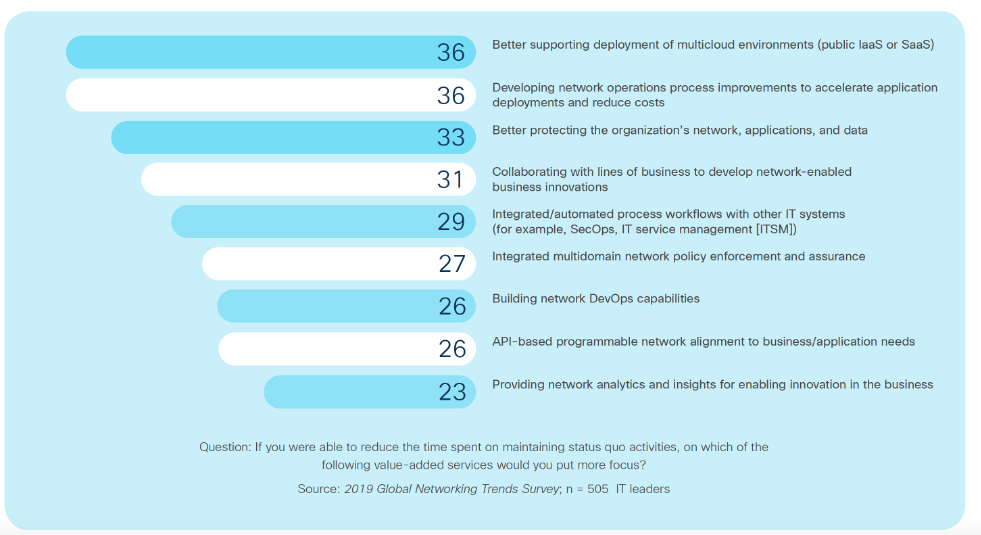Part 1 of 3 for the multicloud-ready network
Some industry leaders are predicting that 2021 will be the year of Multicloud adoption due primarily to the immense flexibility and nimbleness it promises during times of change and uncertainty. With this in mind, it’s all the more important to prepare your network so that it can act as an accelerator and not a roadblock for IT teams needing to make the move.
If given more networking resources, IT leaders said they’d spend their time “better supporting deployment of multicloud environments.” In fact, 36% of IT leaders felt that way, according to our 2020 Global Networking Trends Report.

In my view, there are three fundamental levels of network architecture that IT teams need to consider for a multicloud environment:
- Workload: Simplifying management of workloads and services across a multicloud environment
- Access: Optimizing and securing anywhere access of users and devices to applications anywhere
- Security: Reducing the risk associated with users, devices, and applications dispersed within and beyond the enterprise network
In this three-part blog series, I’ll discuss the role of the network in each one, starting with workload management.
The new application reality is an “Anywhere Data Center”
The emergence of cloud and distributed application models is driving data centers outside of their on-premises confines.The “distributed data center” is a result of applications and data that live both on- and off-premises in hybrid, multicloud environments, and increasingly edge microservices. But a distributed data center does not work like a traditional one. IT organizations need to adapt and shift their technology and operations to meet the increased application and network connectivity demands of this new architecture.
An anywhere data center requires IT teams to ensure technology and operational consistency across the hybrid and multicloud environments.

Networking requirements for managing distributed workloads
Development teams are excited about the positive impact container technology can bring to their applications. Shifting workloads from virtual machines to containers allows developers to deliver changes in a fraction of the time. Once an app is containerized, it is now portable. The teams can move it freely from AWS to Azure to Google Cloud and back to on-premise, optimizing the benefits of a Multicloud environment.
Managing workloads can be a tall task in a multicloud environment. Workloads take the form of Virtual Machines (VMs), containers running directly on top of HW bypassing the hypervisor penalty, or legacy applications running on bare metal. Whatever your environment looks like, provisioning, managing, and maintaining, while providing visibility into these workloads, can be your biggest challenge in a multicloud world.
Each cloud provider has different APIs or constructs to access their resources. It is difficult to move applications built by one cloud provider to another. However, it is highly desirable to have a single and consistent way to manage the networks and security policies for interconnecting applications hosted in different Cloud DCs
Organizations need their multicloud environment (including on-premises) to work as one. Amid all the complexity, the data center and network teams should collaborate to develop consistency across their campus, branch, data center, edge/IoT, and public cloud/SaaS provider domains in order to gain optimized cost, performance, visibility, security, and user experiences.
Intent-based networking to the rescue
Software-defined networking (SDN) and now intent-based networking (IBN) solve many network management lifecycle challenges today, including multicloud connectivity. It gives you a way to simplify and automate management of your cloud connectivity, optimizing network costs and accelerating cloud adoption.

ACI is Cisco’s leading SDN solution, facilitating application agility and data center automation. Through a single platform, you can easily connect multiple cloud environments and interconnect datacenter locations.
ACI implements the automation elements of an intent-based networking framework. It captures high level business intent in the form of a policy and converts this intent into the network constructs to dynamically provision the network, security, and infrastructure. It uses a holistic systems-based approach, with tight integration between hardware and software and physical and virtual elements, an open ecosystem model, to enable unique business value for modern data centers. Here are a few of the benefits of ACI:
- Translates ACI policies into cloud-native constructs through public cloud APIs to create a single, consistent policy abstraction across multiple on-premises and public cloud instances in AWS, Azure, and Google Cloud Platform.
- Allows engineers to extend their on-premises ACI networks into remote locations, bare-metal clouds, colocation providers, and brownfield environment.
- Continues to be the central orchestrator of intersite policies, not only publishing policies to on-premises ACI data-center sites but also pushing the same policies to multiple public cloud sites.
Organizations need to adopt an end-to-end network infrastructure strategy to cope with the unique performance, security, and management challenges of highly distributed applications, data, users, and devices. See Cisco ACI integrations for more detail.
Part one summary
The data center is no longer a place or a fixed location. In today’s world, it’s defined as wherever the data is created, processed, and used. Cisco ACI helps network and cloud architects by extending the capabilities of the innovative ACI solution to any location: small and large, on-premises and remote, private and public cloud, satellite data centers, and 5G-enabled telecom edges.
Stay tuned for part two where we focus on “Access” to the multicloud environment to deliver performance IT anywhere your business needs it.
For a complete look at ACI go here
To continue reading part two and three of “The Three fundamental Elements of a Multicloud-Ready Network click on the links below
Part 2 – What is the second fundamental element you need for a multicloud-ready network?
Part 3 – Is security the most critical element of your Multicloud network? Bien sûr!
ok